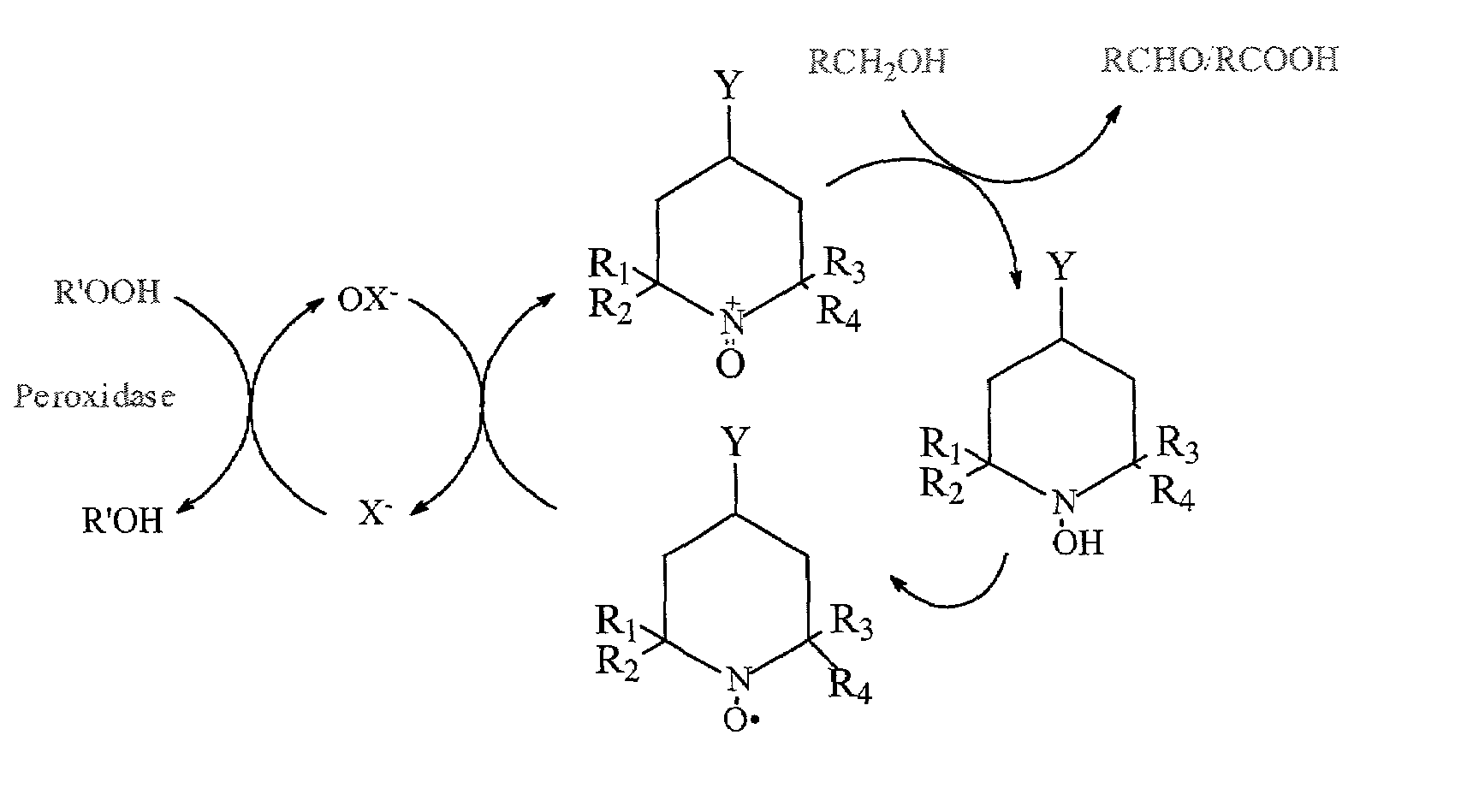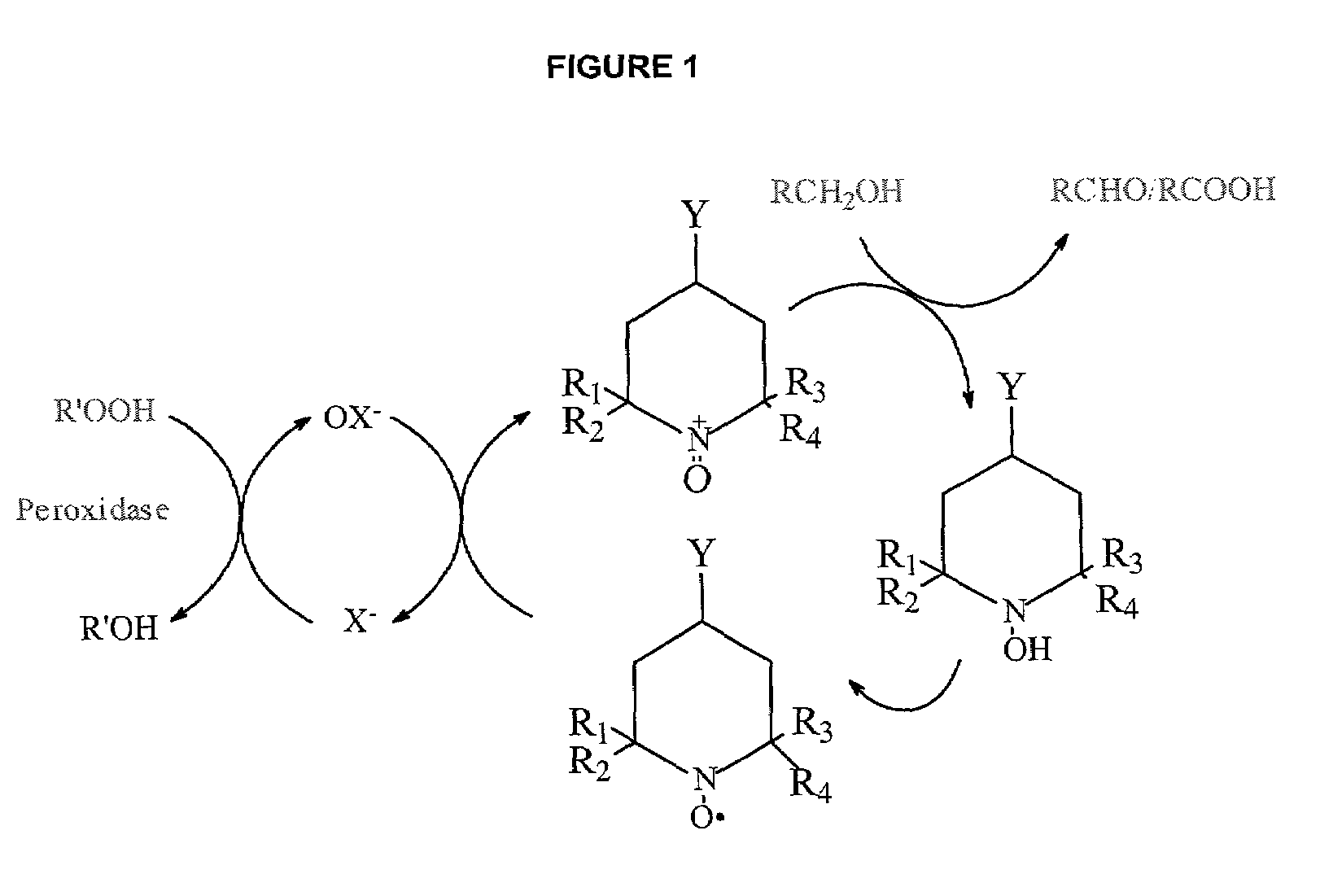Process for the selective modification of carbohydrates by peroxidase catalyzed oxidation
a technology of peroxidase and selective oxidation, which is applied in the field of environmentally friendly process for selective oxidation of carbohydrates, can solve the problems of environmental pollution, excessive carboxyl group formation, and degradation of carbohydrate, and achieves the effects of reducing the number of oxidized carbohydrates
- Summary
- Abstract
- Description
- Claims
- Application Information
AI Technical Summary
Benefits of technology
Problems solved by technology
Method used
Image
Examples
example 1
Oxidation of 4-acetamido-TEMPO (“4-AT”) to the Nitrosonium Ion
[0033]4-AT (0.1 g, widely commercially available) and NaBr (0.5 g) was dissolved in water (25 ml) and the absorbance of the solution at 340 nm was measured in a spectrophotometer. After adding ascorbic acid (0.044 g), the yellow color of the solution almost disappeared and absorbance of the solution recorded. Then, the enzyme LPO (0.4 ml) was added to the solution. Accordingly, the absorbance of the solution increased slightly due to the color of the enzyme. Finally, hydrogen peroxide was added to the solution, until the color of the solution returned to yellow.
[0034]
TABLE 1Absorbance readings of the 4-AT, reduced 4-AT and re-oxidized4-ATSampleABS at 430 nm0.1 g of 4-AT (9.4 mM) and 0.5 g of NaBr0.330Plus 0.044 g of ascorbic acid (4.7 mM)0.104Plus 240 units of LPO0.150Plus 2.5 ml of 0.5% H2O20.317
[0035]The data reported in Table 1 indicates that LPO does catalyze the oxidation of the reduced 4-AT to the corresponding nitr...
example 2
Oxidation of Methyl-Glucopyranoside, (“MGP”)
[0036]MGP (7.5 g, widely commercially available), 4-AT (25 mg), NaBr (1 g), and LPO (5 mg, 600 units from Sigma, L-8257) were added to water (deionized, 50 ml) and dissolved. The mixture was incubated at room temperature and H2O2 (0.9%) was slowly added (30 μl / min). The pH of the reaction was initially increased from 5.0 to 6.4, then decreased (due to the formation of carboxyl groups) and maintained at 6.0 by the slow addition of NaOH (0.1 M ) solution. After three hours, excess H2O2 was destroyed by the addition of 2% catalase (1 ml). Based on titration with hydroxylamine (3.2 ml of 0.2 N NaOH), the aldehyde content of the 50 g of the MGP sample (5.9 g of MGP) was calculated to be 1 mole % based on MGP. Table 2 summarizes the results.
[0037]
TABLE 2Results from LPO catalyzed aldehyde formationH2O2LPONaBr4-ATAldehyde Formation++++Yes+−++No++−+No+++−No+: presence; −: absence
[0038]Oxidation of the MGP to the aldehyde occurred exclusively at th...
example 3
Manipulation of Oxidation Level
[0040]A simple carbohydrate, (“MGP”), was oxidized by slow addition of hydrogen peroxide under various conditions via the procedure described in Example 2 at a constant sodium bromide concentration (1g). The reaction conditions and resultant aldehyde content of the MGP are reported in Table 3.
[0041]
TABLE 3MGP oxidation resultsLPO4-ATAdditionMGP(units / g(% onTimerate ofAldehyde(%)MGP)MGP)(hr)H2O2(mole %)7.5 g800.333.030 μl / min1.0(13)(0.9%)7.5 g801.0 3.030 μl / min1.6(13)(0.9%)7.5 g160 1.3316.6 30 μl / min2.4(13)(0.5%)
[0042]The data in the last row of Table 3 indicated that the formation of 2.4% MGP aldehyde (0.93 mmol) required only 100 mg of 4-AT (0.47 mmol). This indicated that 4-AT was oxidatively cycled.
PUM
| Property | Measurement | Unit |
|---|---|---|
| temperature | aaaaa | aaaaa |
| temperature | aaaaa | aaaaa |
| temperature | aaaaa | aaaaa |
Abstract
Description
Claims
Application Information
 Login to View More
Login to View More - R&D
- Intellectual Property
- Life Sciences
- Materials
- Tech Scout
- Unparalleled Data Quality
- Higher Quality Content
- 60% Fewer Hallucinations
Browse by: Latest US Patents, China's latest patents, Technical Efficacy Thesaurus, Application Domain, Technology Topic, Popular Technical Reports.
© 2025 PatSnap. All rights reserved.Legal|Privacy policy|Modern Slavery Act Transparency Statement|Sitemap|About US| Contact US: help@patsnap.com



